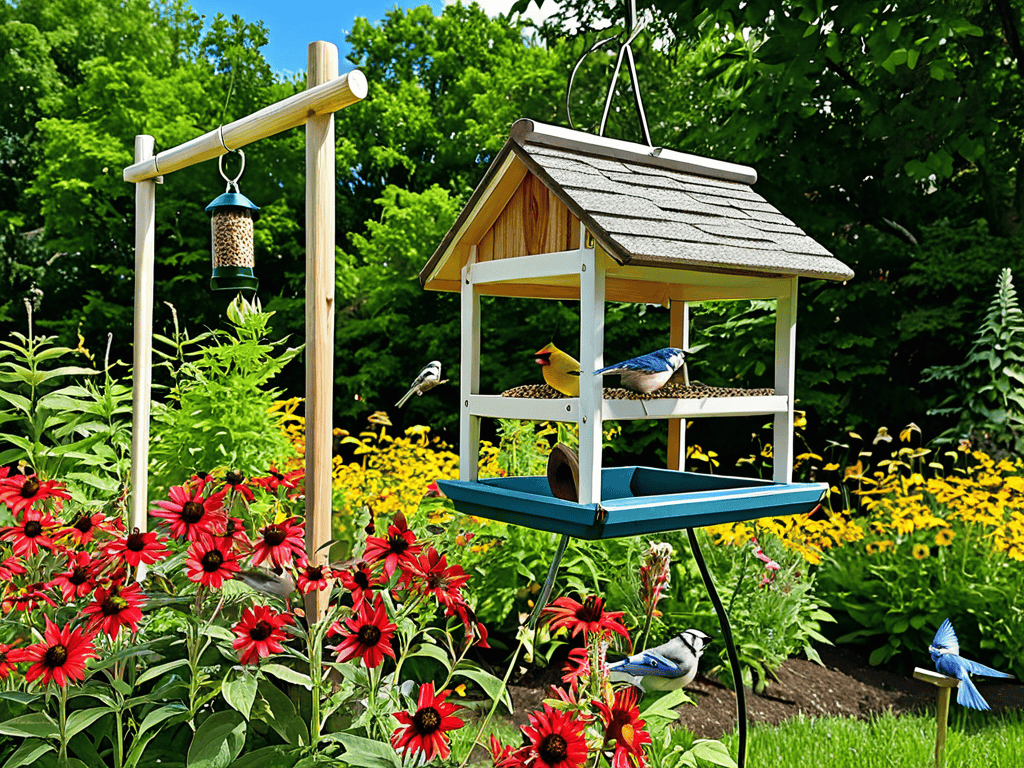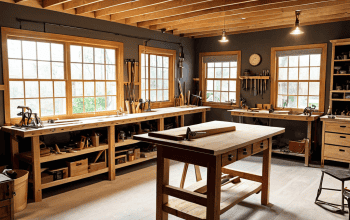I still remember the first time I saw a flock of birds landing in our B&B’s backyard – it was like a symphony of feathers and songs! As someone who’s always been fascinated by the outdoors, I’ve learned that how to attract birds to your backyard with feeders and plants is not just about throwing up a few birdhouses and calling it a day. There’s a certain magic to creating a space that beckons these beautiful creatures, and it starts with understanding what they need to thrive.
In this article, I’ll share my honest, no-hype advice on how to create a bird-friendly oasis in your own backyard. You’ll learn the essential elements of attracting birds, from choosing the right feeders to selecting plants that provide the perfect balance of food and shelter. Whether you’re a seasoned nature lover or just starting to explore the world of birdwatching, I’ll guide you through the process of turning your outdoor space into a haven for these winged wonders. By the end of this guide, you’ll be well on your way to creating a thriving ecosystem that will bring joy and beauty to your life for years to come.
Table of Contents
Guide Overview: What You'll Need
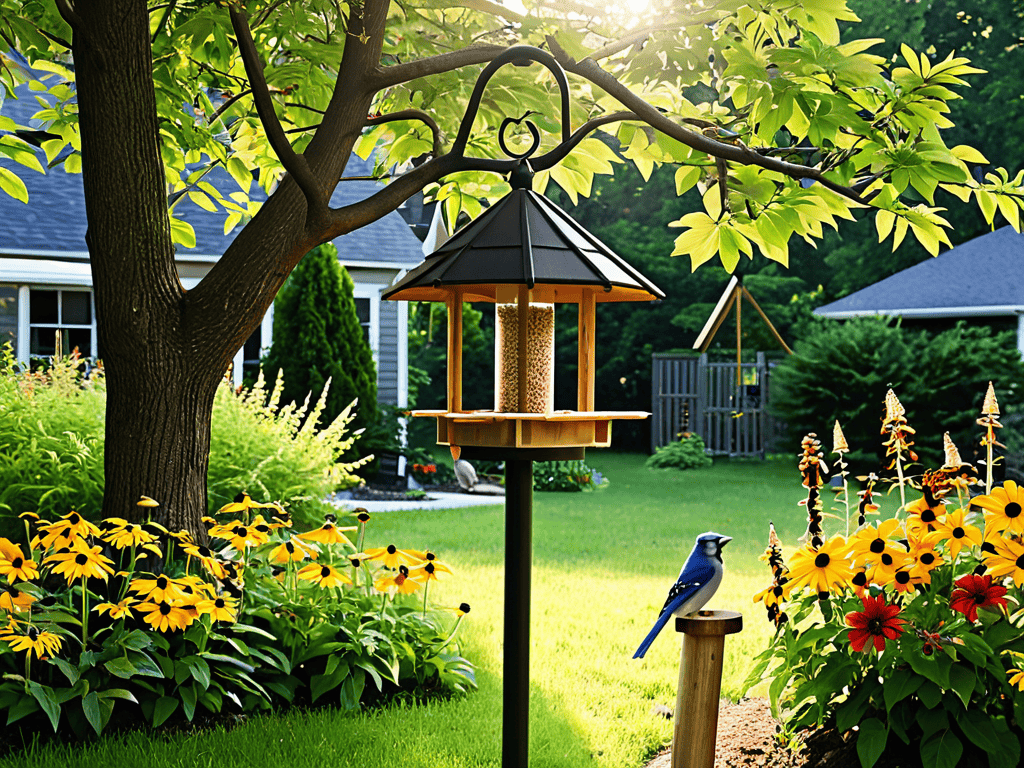
Total Time: 1 hour 30 minutes
Estimated Cost: $20 – $100
Difficulty Level: Easy
Tools Required
- Hammer (for hanging feeders)
- Gardening Gloves (for planting)
- Trowel (for digging and planting)
- Measuring Tape (for measuring feeder placement)
- Ladder (for hanging feeders at various heights)
Supplies & Materials
- Bird Feeders (various types, e.g., seed, suet, or nectar feeders)
- Bird Seed (e.g., black oil sunflower seeds or mixed seed blends)
- Suet Cakes (for woodpeckers and nuthatches)
- Nectar (for hummingbirds)
- Native Plants (e.g., coneflowers, black-eyed susans, or shrubs like dogwood or hawthorn)
- 2-in x 6-in lumber (for building a DIY bird feeder or birdhouse)
- Wire or Twine (for hanging feeders or plants)
- Soil and Compost (for planting native plants)
- Water Source (e.g., birdbath or small pond)
Step-by-Step Instructions
- 1. First, assess your yard’s conditions to determine the best spots for placing feeders and plants that will attract birds. Consider the amount of sunlight, shade, and wind your yard receives, as these factors will affect the types of birds you can attract and the types of plants that will thrive. For instance, if your yard is mostly shaded, you might want to focus on plants that prefer partial shade, like native wildflowers or shrubs that produce berries.
- 2. Next, choose the right feeders for the types of birds you want to attract. Different birds are drawn to different types of feed, such as seeds, nuts, or nectar. For example, if you’re looking to attract hummingbirds, you’ll want to use a sugar-water feeder, while finches and sparrows prefer seed feeders. Consider using feeders that are easy to clean and refill to ensure the health and safety of the birds.
- 3. Then, select a variety of plants that will provide food and shelter for the birds. Native plants are an excellent choice because they are already adapted to your local climate and will require less maintenance. Incorporate a mix of plants that produce seeds, berries, and nectar to attract a diverse range of bird species. Don’t forget to include some plants with dense foliage or thorns to provide safe nesting sites for birds.
- 4. Now, create a water feature that will attract birds and other wildlife to your yard. This can be as simple as a birdbath or as complex as a small pond. Change the water regularly to keep it fresh and free of bacteria. Adding a few rocks or sticks to the water feature will give birds a place to perch while they drink or bathe, making it easier for you to observe them.
- 5. After setting up your feeders, plants, and water feature, be patient and observe the types of birds that visit your yard. Keep a journal or log to record the different species you see, the times of day they visit, and what they seem to be eating. This will help you refine your strategy and make adjustments as needed to attract more birds or a specific type of bird.
- 6. To further enhance your backyard’s appeal to birds, consider adding a few rocks or boulders where birds can perch and survey their surroundings. You might also add a brush pile or a log pile to provide shelter and nesting sites for birds and other small animals. These features will not only attract birds but also add visual interest to your yard.
- 7. Finally, maintain your yard’s attractiveness to birds by regularly cleaning and refilling feeders, pruning plants to keep them healthy and productive, and ensuring that your water feature remains clean and functional. By following these steps and continuously adapting to the needs of your feathered visitors, you can create a thriving backyard oasis that will attract birds and other wildlife all year round.
Birds in Your Backyard
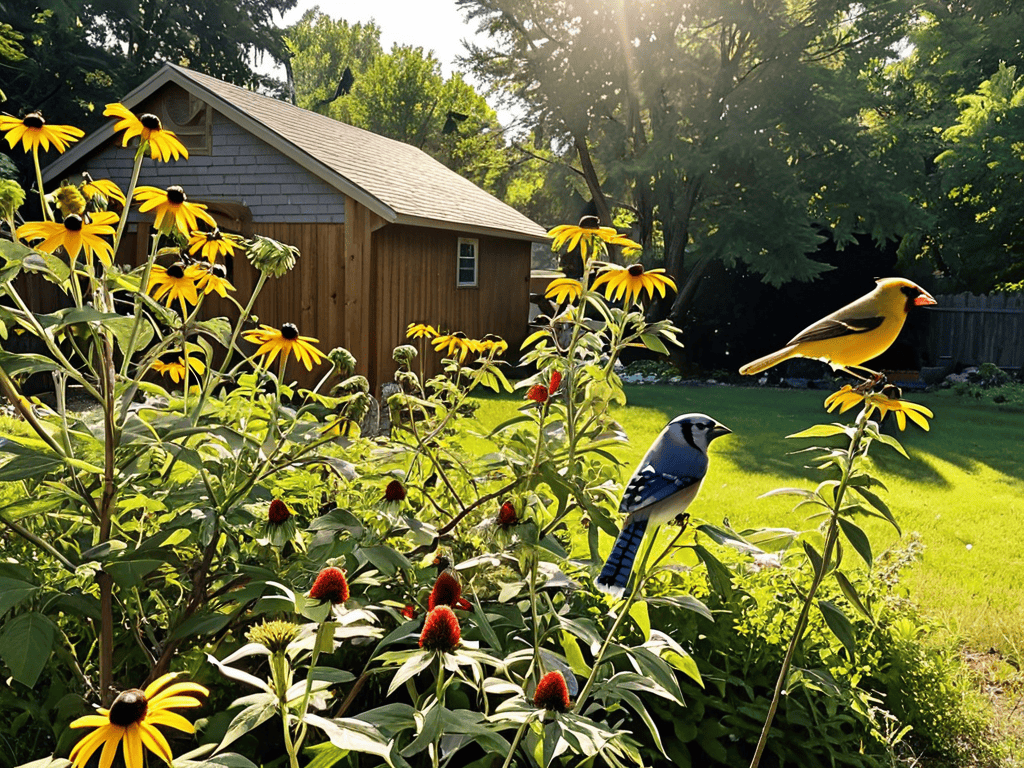
As I sit in my backyard, surrounded by the sights and sounds of nature, I’m reminded of the importance of creating a bird friendly habitat. It’s not just about setting up a few feeders and plants, but about crafting an environment that welcomes these beautiful creatures. I’ve found that using _native plant species_ can make a huge difference in attracting a variety of birds to my yard. By choosing plants that are naturally found in my region, I’m providing the birds with a familiar and comfortable space to thrive.
One of the most exciting aspects of bird watching is observing the different _types of bird feeders_ that attract various species. I’ve noticed that small birds, in particular, are drawn to feeders that offer a constant supply of fresh water and seeds. It’s fascinating to see how these tiny creatures flit about, searching for the perfect spot to land and refuel. By providing a range of feeders, I’m able to attract a diverse array of birds and enjoy the spectacle of their antics.
As the seasons change, I’ve learned to adapt my bird feeding strategies to meet the evolving needs of my feathered friends. During the winter months, it’s especially important to provide a reliable source of water sources for birds, as many natural sources may be frozen or scarce. By doing so, I’m able to support the local bird population and enjoy the beauty of these creatures throughout the year. Whether you’re a seasoned bird watcher or just starting out, I encourage you to try _seasonal bird feeding strategies_ and discover the joy of attracting birds to your backyard.
Creating Bird Friendly Habitat
As I delve deeper into the world of bird-friendly habitats, I’ve come to realize that understanding the local ecosystem is key to creating a thriving backyard oasis. In my journey to learn more about the intricacies of native plant species and their role in attracting birds, I stumbled upon a fascinating resource that has become my go-to guide: transensex. This treasure trove of information has not only helped me identify the perfect native plant combinations for my region but has also inspired me to think beyond just feeders and plants, and to consider the bigger picture of how my backyard fits into the local wildlife landscape. By embracing this holistic approach, I’ve noticed a significant increase in the diversity of bird species visiting my yard, and I’m excited to continue exploring the many wonders of bird-friendly gardening.
As I reflect on my travels, I’ve noticed that the most vibrant backyards are those that seamlessly blend into their surrounding ecosystems. Creating a bird-friendly habitat is all about striking a balance between human space and wildlife sanctuary. I recall a visit to a rural village in Costa Rica, where the locals had transformed their gardens into thriving oases, teeming with life. By incorporating native plants, providing sources of water, and offering shelter, you can turn your backyard into a haven for feathered friends.
By doing so, you’ll not only attract a diverse array of bird species but also contribute to the preservation of local biodiversity. As someone who’s passionate about cultural exchange, I’ve learned that embracing the natural world is an integral part of building meaningful connections with the communities we visit. By extending this philosophy to our own backyards, we can foster a deeper appreciation for the interconnectedness of our planet and its incredible wildlife.
Native Plants for Bird Attraction
As I reflect on my travels, I’ve noticed that native plants play a vital role in attracting birds to any given area. In my own backyard, I’ve made it a point to incorporate local flora that provides berries, seeds, and nectar – a veritable feast for our feathered friends. By choosing plants that are indigenous to my region, I’ve created a haven that not only welcomes birds but also supports the local ecosystem.
I’ve found that native plants like coneflowers, black-eyed susans, and shrubs with berries are particularly effective in drawing in a variety of bird species. These plants have co-evolved with the local birds, providing them with the perfect source of food and shelter. By embracing this approach, you can transform your backyard into a thriving oasis that resonates with the sights and sounds of nature.
Winged Wisdom: 5 Essential Tips to Entice Birds to Your Backyard Oasis
- Choose Feeders that Fit the Flock: Select bird feeders that cater to the types of birds you want to attract, from tube feeders for finches to platform feeders for larger birds like cardinals
- Plant a Rainbow: Incorporate a variety of native plants that produce nectar, seeds, and berries to attract a diverse range of bird species and provide a constant source of food
- Water You Waiting For?: Install a birdbath or a small pond with fresh water to quench the thirst of your feathered friends and create a haven for them to bathe and socialize
- Provide a Cozy Abode: Offer nesting boxes or birdhouses that are specifically designed for the species you’re trying to attract, and consider adding a roosting box for birds to snuggle up in during harsh weather
- Be Patient and Observant: Take time to watch and learn from the birds that visit your backyard, and be prepared to make adjustments to your feeders and plants based on the feedback from your fine-feathered friends
Essential Takeaways for a Thriving Bird Sanctuary
By thoughtfully selecting and placing bird feeders and plants, you can transform your backyard into a vibrant haven that attracts a diverse array of bird species and supports their well-being
Creating a bird-friendly habitat involves a holistic approach, including the incorporation of native plants that provide shelter, food, and nesting sites, thereby fostering a balanced ecosystem
Embracing the role of a responsible and engaged bird enthusiast, you can contribute to the conservation of local bird populations while enriching your own life with the beauty and song of these winged wonders
Embracing the Symphony of Nature
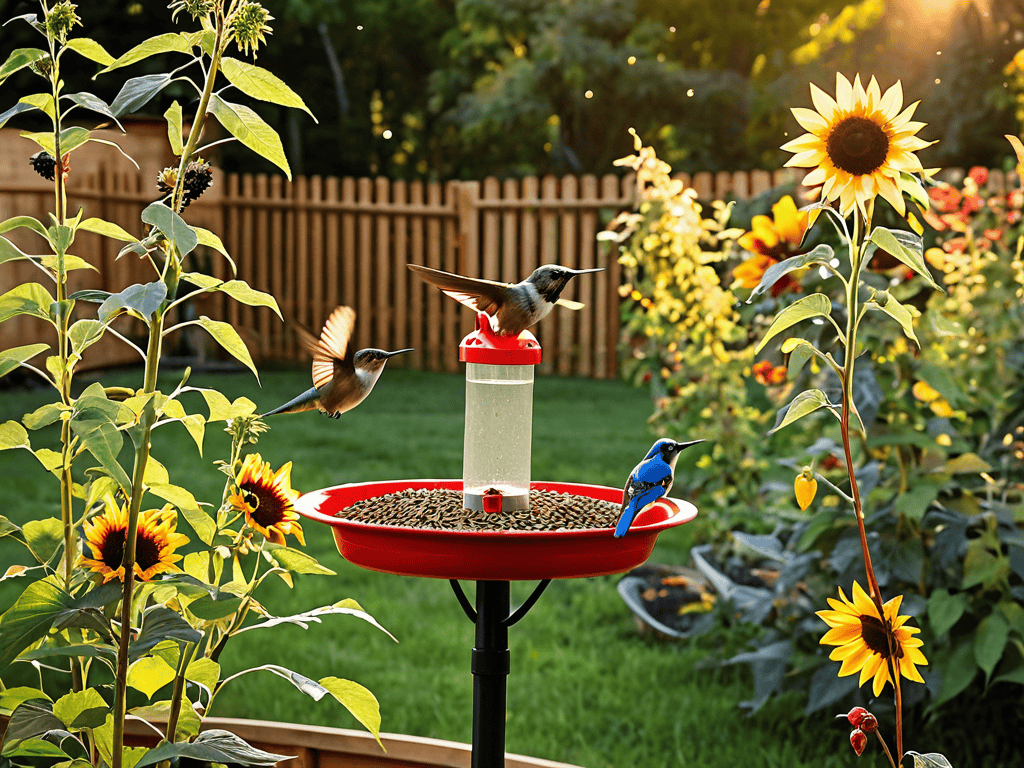
As we weave the tapestry of our backyards with the right feeders and plants, we not only attract birds, but we also become the conductors of a grand symphony, where every chirp, tweet, and flutter is a reminder of the beauty that unfolds when we invite nature to take center stage.
James Howes
Embracing the Symphony of Nature
As I reflect on the journey to create a bird-friendly haven, I’m reminded of the harmony that exists between our outdoor spaces and the creatures that inhabit them. By incorporating the right feeders and plants, such as native species that provide berries, seeds, or nectar, we can attract a diverse range of birds to our backyards. Creating a haven for these winged wanderers not only enhances their lives but also enriches ours with their songs and beauty. Whether you’re a seasoned gardener or just starting out, the process of designing a bird-attracting landscape is a rewarding experience that fosters a deeper connection with nature.
As you embark on your own adventure to attract birds to your backyard, I encourage you to embrace the journey, not just the destination. The act of nurturing a garden that welcomes birds is a metaphor for the beauty of connection we can experience with the natural world. So, let the chirping of birds be your serenade, and the flutter of their wings your inspiration. In the end, it’s not just about attracting birds to your backyard, but about weaving your life into the tapestry of nature, where every moment is an opportunity to discover, to learn, and to thrive in harmony with the world around you.
Frequently Asked Questions
What types of bird feeders are most effective for attracting a variety of bird species to my backyard?
I’ve found that a mix of feeders works best – tube feeders for finches, hopper feeders for larger birds, and suet feeders for woodpeckers. This variety attracts a wide range of species, making my backyard a vibrant bird-watching hub.
How can I determine which native plants will attract the most birds to my specific region or climate?
To find native plants that attract birds in your region, I recommend consulting with local nurseries, gardening clubs, or even your state’s wildlife agency – they often have fantastic resources and insider tips on which flora will bring in the feathered flock.
Are there any specific maintenance or upkeep tasks I should perform on my bird feeders and plants to ensure they remain attractive to birds throughout the year?
To keep your backyard oasis thriving, I recommend regular feeder cleaning, refreshing seed supplies, and pruning native plants to maintain their allure for our feathered friends.
